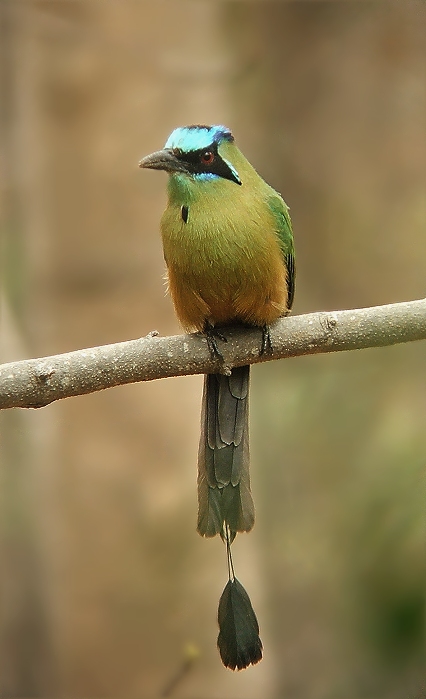(Redirecting to Blue-crowned Motmot) |
(split) |
||
| Line 1: | Line 1: | ||
| − | + | [[Image:Blue-crowned_Motmot.jpg|thumb|550px|right|Photo by {{user|mmdnje|mmdnje}} <br />Botanical Garden, Guayaquil. [[Ecuador]], December 2005]] | |
| + | ;[[: Category:Momotus|Momotus]] subrufescens | ||
| + | |||
| + | ==Identification== | ||
| + | 38-48 cm<br /> | ||
| + | Green upperparts (olive in subspecies ''osgoodi''), green or rufous underparts depending on subspecies (very variable how dark), black central spot on upper breast, black central crown surrounded by blue band, black eyemask sometimes edged pale at the back. | ||
| + | |||
| + | Tail is green with blue lower tail with two longest feathers showing an area missing barbs followed by an area with barbs (rackets); the tip of these feathers is black in some subspecies. | ||
| + | |||
| + | Notice that the tail feathers are normal when growing, the barbs fall off shortly after, and it is therefore possible to see a bird of this species that is missing rackets (feathers may also break below the rackets). | ||
| + | |||
| + | '''Juvenile''' has reduced black on upper breast. | ||
| + | ==Distribution== | ||
| + | From [[Panama]] to [[Colombia]], [[Venezuela]], [[Ecuador]] and [[Peru]]. | ||
| + | ==Taxonomy== | ||
| + | Seven subspecies recognized: | ||
| + | * ''M. s. spatha'' in eastern [[Colombia]] (Serrania Macuira in eastern Guajira) | ||
| + | * ''M. s. olivaresi'' in eastern [[Colombia]] | ||
| + | * ''M. s. subrufescens'' on the Caribbean coast of northern [[Colombia]] and [[Venezuela]] | ||
| + | * ''M. s. conexus'' from [[Panama]] (Canal Zone) to northern [[Colombia]] (lower Río Cauca) | ||
| + | * ''M. s. reconditus'' from eastern [[Panama]] to northern [[Colombia]] (Atrato Valley) | ||
| + | * ''M. s. osgoodi'' in the humid forests of western [[Venezuela]] (Lake Maracaibo region) | ||
| + | * ''M. s. argenticinctus'' in tropical western [[Ecuador]] and northwestern [[Peru]] | ||
| + | This species was formerly considered conspecific with [[Blue-crowned Motmot]]. | ||
| + | ==Habitat== | ||
| + | Habits near water, rivers, streams, and builds its nest in hollows excavated on banks. Likes to perch on branches in the shadow, inside forest, in hedgerows, or in scrub. | ||
| + | ==Behaviour== | ||
| + | ====Breeding==== | ||
| + | It nests in tunnels in a bank, 3-4 white eggs are laid. | ||
| + | ====Diet==== | ||
| + | The diet includes insects, lizards and fruit. | ||
| + | ====Vocalisation==== | ||
| + | A single "whoop". | ||
| + | ==References== | ||
| + | # Clements, James F. 2007. ''The Clements Checklist of Birds of the World''. 6th ed., with updates to October 2007. Ithaca: Cornell University Press. ISBN 9780801445019 | ||
| + | # F. Gary Stiles 2009. A REVIEW OF THE GENUS MOMOTUS (CORACIIFORMES: MOMOTIDAE) IN NORTHERN SOUTH AMERICA AND ADJACENT AREAS. [http://www.ornitologiacolombiana.org/oc8/Stiles.htm#1in Ornitología Colombiana No.8 (2009): 29-75]. Subject of Birdforum discussion [http://www.birdforum.net/showthread.php?p=1564833 here] | ||
| + | #{{Ref-Clements6thDec08}} | ||
| + | {{ref}} | ||
| + | ==External Links== | ||
| + | {{GSearch|Momotus+subrufescens}} | ||
| + | [[Category:Birds]] [[Category:Momotus]] | ||
Revision as of 18:49, 18 February 2011
- Momotus subrufescens
Identification
38-48 cm
Green upperparts (olive in subspecies osgoodi), green or rufous underparts depending on subspecies (very variable how dark), black central spot on upper breast, black central crown surrounded by blue band, black eyemask sometimes edged pale at the back.
Tail is green with blue lower tail with two longest feathers showing an area missing barbs followed by an area with barbs (rackets); the tip of these feathers is black in some subspecies.
Notice that the tail feathers are normal when growing, the barbs fall off shortly after, and it is therefore possible to see a bird of this species that is missing rackets (feathers may also break below the rackets).
Juvenile has reduced black on upper breast.
Distribution
From Panama to Colombia, Venezuela, Ecuador and Peru.
Taxonomy
Seven subspecies recognized:
- M. s. spatha in eastern Colombia (Serrania Macuira in eastern Guajira)
- M. s. olivaresi in eastern Colombia
- M. s. subrufescens on the Caribbean coast of northern Colombia and Venezuela
- M. s. conexus from Panama (Canal Zone) to northern Colombia (lower Río Cauca)
- M. s. reconditus from eastern Panama to northern Colombia (Atrato Valley)
- M. s. osgoodi in the humid forests of western Venezuela (Lake Maracaibo region)
- M. s. argenticinctus in tropical western Ecuador and northwestern Peru
This species was formerly considered conspecific with Blue-crowned Motmot.
Habitat
Habits near water, rivers, streams, and builds its nest in hollows excavated on banks. Likes to perch on branches in the shadow, inside forest, in hedgerows, or in scrub.
Behaviour
Breeding
It nests in tunnels in a bank, 3-4 white eggs are laid.
Diet
The diet includes insects, lizards and fruit.
Vocalisation
A single "whoop".
References
- Clements, James F. 2007. The Clements Checklist of Birds of the World. 6th ed., with updates to October 2007. Ithaca: Cornell University Press. ISBN 9780801445019
- F. Gary Stiles 2009. A REVIEW OF THE GENUS MOMOTUS (CORACIIFORMES: MOMOTIDAE) IN NORTHERN SOUTH AMERICA AND ADJACENT AREAS. Ornitología Colombiana No.8 (2009): 29-75. Subject of Birdforum discussion here
- Clements, JF. 2008. The Clements Checklist of Birds of the World. 6th ed., with updates to December 2008. Ithaca: Cornell Univ. Press. ISBN 978-0801445019.
Recommended Citation
- BirdForum Opus contributors. (2024) Whooping Motmot. In: BirdForum, the forum for wild birds and birding. Retrieved 11 May 2024 from https://www.birdforum.net/opus/Whooping_Motmot




